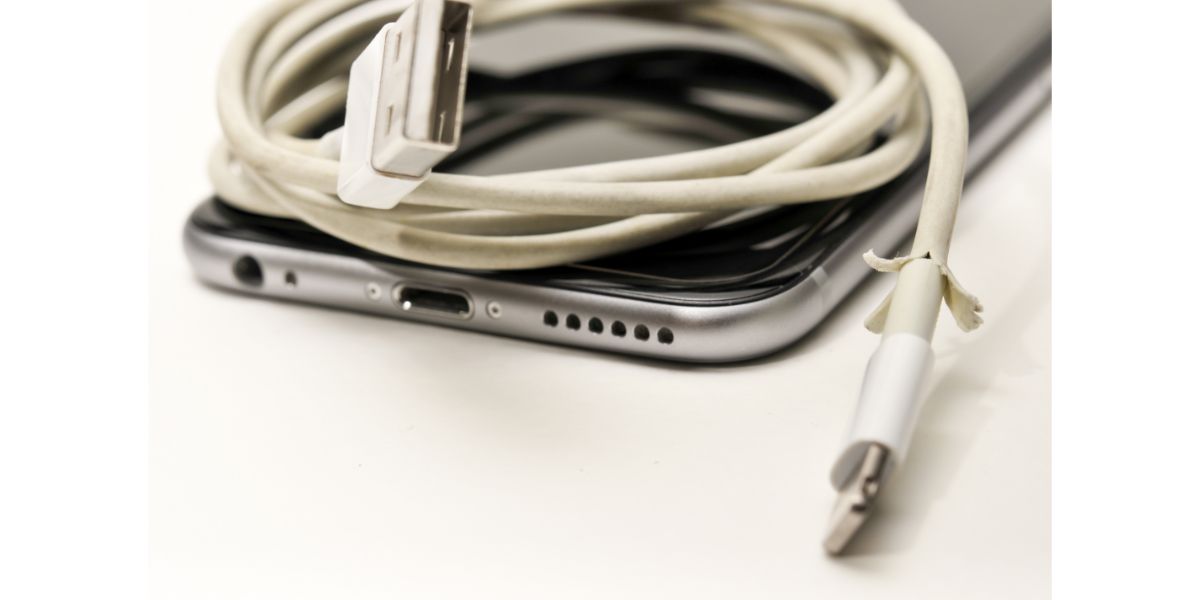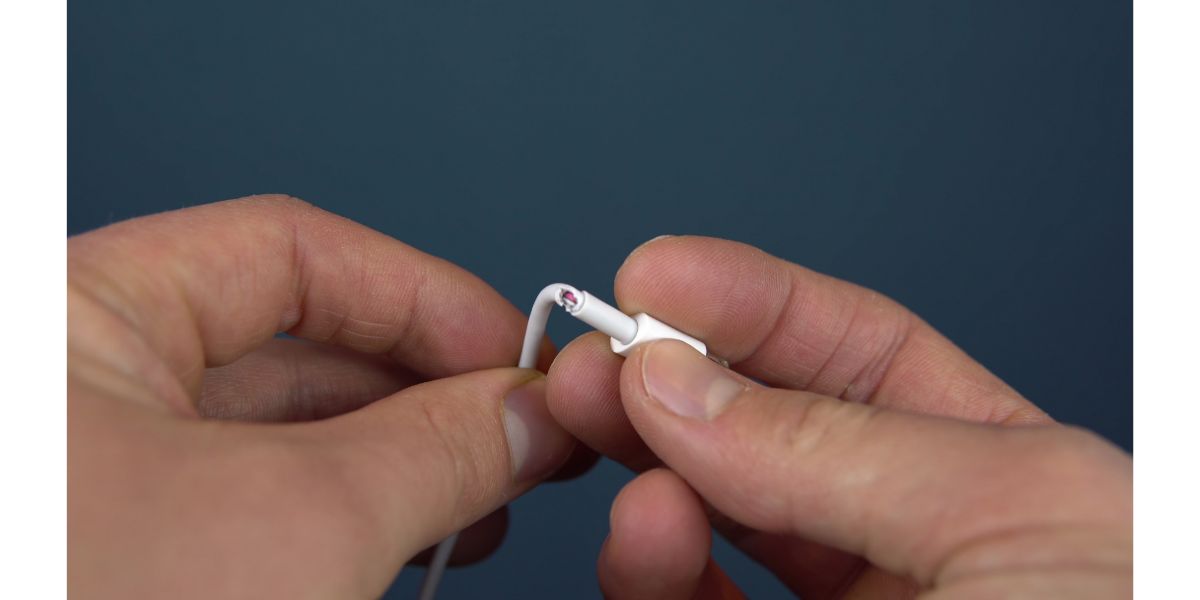Disclaimer: This post may contain affiliate links, meaning we get a small commission if you make a purchase through our links, at no cost to you. For more information, please visit our Disclaimer Page.
iPhones are considered among the best smartphones in the market, but, unfortunately, their chargers don’t have the same reputation. It’s pretty common to buy an iPhone with a complementary charger and then replace the charger just a couple months later.
Why are iPhone chargers so fragile, and how can you ensure they don’t break so frequently?
Table of Contents
4 Reasons iPhone Chargers Are So Fragile
It’s not just you; iPhone chargers are notoriously breakable, with a lifespan that can be as short as a couple of weeks. A few different factors cause these chargers to start malfunctioning or simply stop working.
Some of these reasons are inherent, which means they are built-in in every charger you buy. These factors are out of your hands. However, the way you use and handle the chargers also makes a difference and can cause damage that could otherwise be easily avoided.
While you can’t do much about the built-in weaknesses of iPhone chargers, you can definitely follow specific rules to use them in a way that does not damage them. We will guide you through these rules later, but first, let’s take a look at a few reasons why your iPhone charger breaks easily:
1. Less Durable Cable Material
Unfortunately, the problem starts at the very beginning, with the manufacturing process of Apple chargers. The materials used for these chargers are not as resistant as they used to be years ago because of decisions made regarding the aesthetics and health effects of the chargers.
Apple used to produce charger cables that had ribbed strain relief. This type of cable is reinforced to resist dynamic stressors, extending the charger’s lifespan by a significant amount. However, this cable style was abandoned in favor of the sleeker and simplistic-looking cable with the plastic cover you use today.
Additionally, Apple chargers are currently made out of non-toxic materials. While these materials are non-toxic, they can’t replace the strength of polyvinyl chloride (PVC), which was used for chargers before the initiative.
PVC is commonly used for electric wires because it is incredibly resistant and durable. Unfortunately, it is also toxic, contributing to respiratory issues and other health problems, especially in children. Consequently, Apple does not use it for charger cable manufacturing anymore.
While removing PVC is good news for your well-being, it’s bad news for the longevity of your charger cables.
2. Aged Chargers
The more often your charger is used and moved, the more fragile it gets. The average lifespan of a good Apple charger is about a year, so it makes sense if yours is starting to show signs of malfunctioning after 12 months.
There isn’t much you can do about an old charger. If you are careful and take care not to mishandle it, you’re already doing your best. Replace the charger as soon as you realize it doesn’t work properly anymore.
3. Counterfeit Chargers
There are hundreds of different iPhone chargers that you can find in different stores at various price points. Many of these chargers are made by unauthorized manufacturers and cost much less than original Apple chargers.
There’s a catch, though. Unfortunately, these counterfeit chargers are more likely to stop working or malfunction. They are made of much cheaper materials that are less durable.
4. Handling the Charger Incorrectly
As you can see, iPhone chargers can be inherently fragile before you even take them out of the box. However, they can last a long time if handled and used correctly. Unfortunately, most people are unaware of how they can damage their charger every time they use it, causing it to stop working shortly after purchasing it.
It’s important to learn about all the ways in which you may be misusing your iPhone charger so that you can avoid doing it in the future. Here are some mistakes you may be making while using your charger:
Pulling the Cable Too Hard To Unplug It From Your Phone
This happens to everyone, and you can’t always control it; you’re in a hurry, so you pull the cable quickly to disconnect the charger from your phone. Pulling the cable too fast can damage it, especially the section at the end that goes into your phone.
You may also not pay attention to how hard you pull the charger cable, but it makes a difference. If you remove the cable too hard to disconnect it from your phone, you increase the chances of it malfunctioning.
Improperly Wrapping the Cable
Whenever you need to take your charger with you to another location, you wrap it and put it into your bag or your pocket in order to use it later. How you wrap your charger cable is crucial and often leads to irreparable damage.
If you haphazardly stuff the charger cable in your pocket when you’re in a hurry, you can be sure that it won’t last long. The way the cable bends can disconnect wires and make the charger stop working.
Using the Phone While Charging
Yes, we all do it, but it doesn’t make it right; using and moving your iPhone while it’s connected to a charger can cause the cable to break more easily. Sometimes it’s unavoidable, but other times, it’s better to refrain from using your phone while it’s charging and concentrate on other tasks.
When you use your phone while connected to a charging cable, you inevitably move it and put tension on it, which weakens the cable. The more you handle your phone while charging, the more you risk breaking your charger cable.
Additionally, using the phone while charging can damage the phone battery as well. The battery struggles to perform tasks while being charged, which causes it to heat up considerably. As a result, it grows weaker with time.
3 Signs That Your iPhone Charger Is on Its Way Out
A lot of chargers can give you signs that there’s something wrong before they stop working altogether. Whenever you see those signs, stop using the charger and buy a new one. A defective charger can do more harm than good to your phone.
1. There Is Visible Damage
We’ve all had that one charger that looks like it’s hanging by a thread, and we may have used it for a long time with no issues. However, it’s not a good idea to keep using a charger if it has visible signs of damage because chances are it does not work properly.
Signs of physical damage in a charger cable are pretty recognizable. The cable looks worn and thinned out. In some parts, you may even see exposed metal wires. Typically, the most vulnerable part of the charger cable is the section nearest to the head.
If your charger is bent in an unusual way or broken, or the sleeve is worn out, throw it away and buy a new one. Even though it may still work, it is clearly on its way out and could damage your phone’s battery.
2. Only Works if You Keep the Cable in a Certain Position
Sometimes your charger looks brand new, but it doesn’t charge your phone properly. It might keep connecting and then disconnecting whenever you move your phone, or it may only work if the cable is positioned in a certain way.
Even though it might look fine on the outside, a charger that disconnects on its own is broken and needs to be replaced. The constant connecting and disconnecting can drain the battery life of your phone.
3. Takes a Long Time To Charge Your Phone
Your charger may not have signs of damage on the outside and may not disconnect out of nowhere, but it may take a long time to charge your phone. If it takes your charger more than two to three hours to charge your phone, it’s time to get a replacement.
The fact that it takes a long time to fully charge a phone indicates a problem with the charger, and continuous, split-second disconnections may damage your phone.
How To Keep Your iPhone Charger From Breaking (3 Tips)
Now that you know what makes iPhone chargers so fragile and the mistakes people make while using them, you have an idea of what you need to do to extend the lifespan of your own charger.
To be sure, we’ve included a list of helpful instructions so that you remember exactly what you need to do to keep your iPhone charger from breaking.
1. Buy Original Chargers
Yes, Apple chargers are quite expensive. They may make you wonder if they’re really worth the money, especially considering the fact that they are no longer made of particularly resistant materials, as we explained above.
However, consider the alternative; cheap counterfeit chargers exist, but they’re made of more affordable and weaker materials. Buying an original at least guarantees that it will last as long as you use it carefully.
2. Reinforce the Cable
Given that iPhone chargers are not made of very durable materials, you can take it upon yourself to make them last longer. You can achieve this in several ways, depending on how much effort and money you’re willing to spend. You can try the following:
- Putting a pen spring around the cable. Use the small spring you can find inside the click pens to reinforce the charger cable.
- Using embroidery thread. You can use embroidery thread to reinforce your charger cable. Just make sure that the thread is much longer than the cable length and that you braid it tightly.
- Using electrical tape. This is usually an acceptable fix if you see signs of damage, but you can also use it to reinforce the whole cable.
- Using cable protectors. You can find cable protectors online or in electronics stores. These rubber or silicone pieces are especially helpful for strengthening the most delicate part of the cable, near the head.
3. Do Not Mishandle the Charger
You’ve learned by now that charger cables can easily be damaged by how you handle them. You need to remember specific tips that can help you keep your charger for as long as possible.
- Unplug the phone from your charger using the head, not pulling the cable.
- Don’t use or move the phone while it’s charging.
- Avoid leaving it in an environment that is too hot or too cold.
- Don’t strain the cable by placing your phone at a distance from the outlet.
- Don’t bend the cable.
- Keep the charger away from water and moisture.
- Don’t wrap the cable carelessly when taking it with you.
- Don’t leave it lying around when you’re not using it.
- Keep the charging cable away from children and pets.
It’s not easy to remember all these rules for such a mundane task, but it helps to keep some of them in mind enough that they become second nature.
Considering Wireless Chargers
Considering everything we have explained so far, you may be wondering about an alternative to iPhone cable chargers that is more durable and easier to handle. Wireless chargers may come to mind as a possible solution.
Wireless chargers can last longer because they involve much less handling and moving. You can take them anywhere and use them with all types of phones. How come these chargers aren’t more popular?
The problem with wireless chargers is that they are too slow. It can take twice as much time to charge your iPhone on a wireless pad compared to a regular wire charger. The reason why this happens is that wireless chargers inefficiently use energy.
Additionally, these chargers can be fussy in their own way. To charge your phone, you need to place it in a specific position on the charging pad. If you put it in the wrong position, it will not start charging, and you may not even notice.
Conclusion
There are several different reasons why iPhone chargers break easily, from certain manufacturer decisions about the aesthetics of the cables to the way you wrap them when you move them. Try to be more careful while using them and reinforce the cable to make sure your iPhone charger lasts longer.



